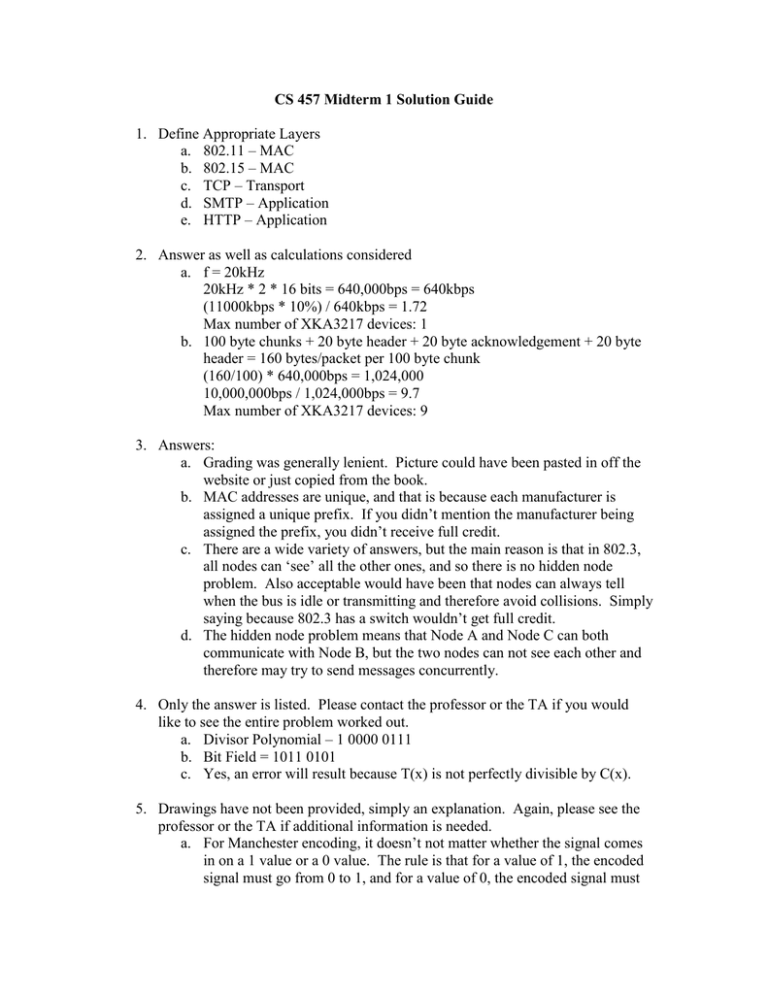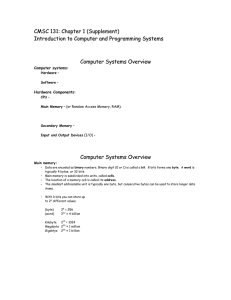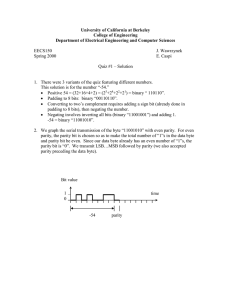CS 457 Midterm 1 Solution Guide 1. Define Appropriate Layers
advertisement

CS 457 Midterm 1 Solution Guide 1. Define Appropriate Layers a. 802.11 – MAC b. 802.15 – MAC c. TCP – Transport d. SMTP – Application e. HTTP – Application 2. Answer as well as calculations considered a. f = 20kHz 20kHz * 2 * 16 bits = 640,000bps = 640kbps (11000kbps * 10%) / 640kbps = 1.72 Max number of XKA3217 devices: 1 b. 100 byte chunks + 20 byte header + 20 byte acknowledgement + 20 byte header = 160 bytes/packet per 100 byte chunk (160/100) * 640,000bps = 1,024,000 10,000,000bps / 1,024,000bps = 9.7 Max number of XKA3217 devices: 9 3. Answers: a. Grading was generally lenient. Picture could have been pasted in off the website or just copied from the book. b. MAC addresses are unique, and that is because each manufacturer is assigned a unique prefix. If you didn’t mention the manufacturer being assigned the prefix, you didn’t receive full credit. c. There are a wide variety of answers, but the main reason is that in 802.3, all nodes can ‘see’ all the other ones, and so there is no hidden node problem. Also acceptable would have been that nodes can always tell when the bus is idle or transmitting and therefore avoid collisions. Simply saying because 802.3 has a switch wouldn’t get full credit. d. The hidden node problem means that Node A and Node C can both communicate with Node B, but the two nodes can not see each other and therefore may try to send messages concurrently. 4. Only the answer is listed. Please contact the professor or the TA if you would like to see the entire problem worked out. a. Divisor Polynomial – 1 0000 0111 b. Bit Field = 1011 0101 c. Yes, an error will result because T(x) is not perfectly divisible by C(x). 5. Drawings have not been provided, simply an explanation. Again, please see the professor or the TA if additional information is needed. a. For Manchester encoding, it doesn’t not matter whether the signal comes in on a 1 value or a 0 value. The rule is that for a value of 1, the encoded signal must go from 0 to 1, and for a value of 0, the encoded signal must go from 1 to 0. Many people had the encoded signal exactly inverted and so half a point was taken off. b. For NRZ-I, it does matter whether the signal comes in with a value of 1 or 0, and so two possible answers were accepted. Basically, for a value of 1, the encoded systems goes from 0 to 1, or 1 to 0, and for a value of 0, there is no change in the level of the encoded signal. 6. Answers: a. Single bit errors can be detected using two-dimensional parity because, based on which column and row have an incorrect parity value, you can easily determine the single bit which is incorrect. b. There is no single correct answer. For example, an example can be constructed in which three columns have 2 single bit errors, and three different columns have 2 single bit errors, and so these errors can’t be detected. c. Using the method taught in class for performing even parity which means converting the most significant bit of every 16 bit to a 1, and adding two 16 bit parity codes, you are left with: F4 01 C0 FF 90 00 A4 FF 80 04 90 72 A1 01 B1 77. If the odd parity method is used, where each column must be made odd, then the sequence is: 74 01 40 FF 10 00 DB 01 00 04 10 72 21 01 CE 88. 7. Answer: a. M = 2hops L = 3000km / 300000 km/s = 0.1 seconds B = 8000 bits W = 1 Mbps P = 15ms Time = 3ML + B/W + (M-1)P = 3(2)(0.1) + 8000/1000000 + (1)(.015s) = 0.6158 seconds b. N = 1 T = 8000 bits / 1000000 bps = 0.008s Time = ML + NT + (M-1)T + (M-1)P = (2)(0.1) + (1)(0.008) + (2-1)(0.008) + (2-1)(0.015) = 0.231 sec 8. Answers: a. 7E 80 7D 5E 7D 5D 5E 5D E9 5D 7E – Although we were looking for the 7E symbols at the beginning and end, you still received full credit even if you didn’t insert them. b. The receiver must simply take every 7D 5E sequence it sees and convert it to 7E and take every 7D 5D sequence it sees and convert it to 7D. 9. Answers: a. The vulnerable period is the time interval during which the arrival of packet B implies a collision with packet A. b. 2.5 ms c. The efficiency for this protocol will be between that of regular and slotted aloha: 18% < E < 36% 10. There are two possible answers for this problem. Both are arrived at by using the data to understand who a node’s neighbors are. The possible answers are B E D A C (or C A D E B) or E B D C A (A C D B E) 11. Answers: a. Twisted Pair b. Star topology c. 46 bytes or 64 bytes d. Max packet size = 1518 bytes, so (1518 * 8) / 100,000,000 = 0.000121s 12. Cable modems have a higher bandwidth than ADSL modems, which vary depending on the users distance from the central telephone office. However, cable bandwidth is affected by the number of concurrent users in a neighborhood, in that since a line is shared, more concurrent users means lower bandwidth per user.



